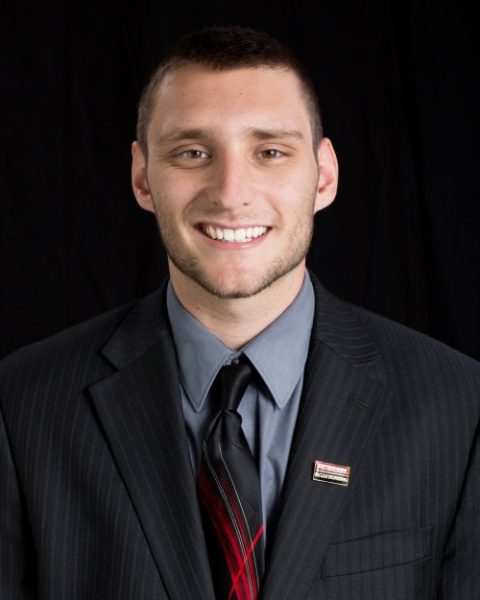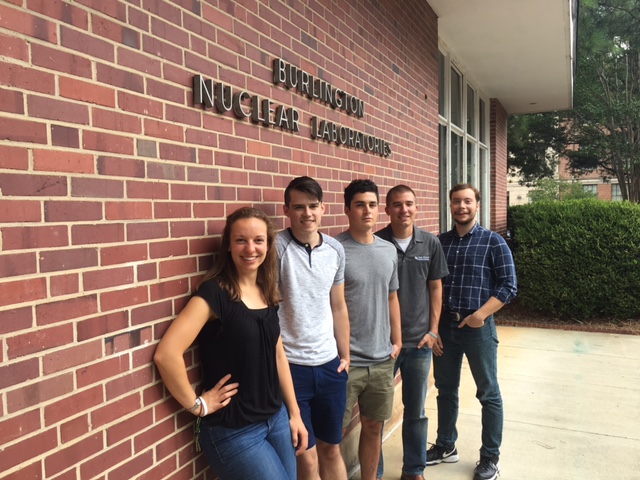Four students in the Department of Nuclear Engineering at North Carolina State University have been chosen for fellowships through the Nuclear Energy University Program (NEUP) fellowship.Three of the four are currently attending graduate school in nuclear engineering at NC State, while the fourth is a first year Ph.D. student at Vanderbilt University. NEUP awards a maximum of three fellowships per university, and NC State is the only university to receive all three. In addition to the NEUP fellows, two other graduate students in the Department of Nuclear Engineering have received national fellowships in 2016.
The Department of Energy (DOE) is awarding more than $5 million for 57 undergraduate scholarships and 33 graduate fellowships to students across the nation pursuing disciplines related to nuclear energy. This includes the NEUP fellowship, designed to help lead the nation’s development and exploration of advanced nuclear science and technology.
 Brandon Chisholm, a Raleigh native and lifelong fan of the Wolfpack, always knew that he wanted to study engineering at NC State, where he received his B.S. in nuclear engineering. After touring the PULSTAR reactor, he knew that he wanted to understand the principles of nuclear engineering, which eventually led to his decision to work as a student operator of the reactor and to work as a summer intern at Duke Energy’s Harris Nuclear Plant. Chisholm loved his time at NC State so much that he was ranked first in the student Wolfpack Club at one point for accumulating the most minutes of attendance at non-revenue sport events. He is attending Vanderbilt University during the fall semester to begin research for his fellowship. Chisholm’s research is focused on the development of a Generation IV nuclear reactor design, the Molten Chloride Fast Reactor (MCFR), in hopes that a commercial-scale MCFR can be built. He also hopes that advanced reactor designs will provide a solid argument for the revival of nuclear power in the United States.
Brandon Chisholm, a Raleigh native and lifelong fan of the Wolfpack, always knew that he wanted to study engineering at NC State, where he received his B.S. in nuclear engineering. After touring the PULSTAR reactor, he knew that he wanted to understand the principles of nuclear engineering, which eventually led to his decision to work as a student operator of the reactor and to work as a summer intern at Duke Energy’s Harris Nuclear Plant. Chisholm loved his time at NC State so much that he was ranked first in the student Wolfpack Club at one point for accumulating the most minutes of attendance at non-revenue sport events. He is attending Vanderbilt University during the fall semester to begin research for his fellowship. Chisholm’s research is focused on the development of a Generation IV nuclear reactor design, the Molten Chloride Fast Reactor (MCFR), in hopes that a commercial-scale MCFR can be built. He also hopes that advanced reactor designs will provide a solid argument for the revival of nuclear power in the United States.
An outdoor sports enthusiast, Cole Manring will work to link results from atomistic simulations with larger engineering codes in order to predict the complex behavior of nuclear fuel that could lead to the design of safer, more novel fuel types. Manring said that his experience as an undergraduate at NC State created a strong foundation for his current research path and instilled the ownership, pride and perseverance that resulted in his success. Manring was born in High Point, NC and graduated from Wesleyan Academy. He said, “I always knew that I wanted to find a field that would bridge the gap between physics and engineering, and after a tour of the PULSTAR reactor with my high school AP physics class, I knew that nuclear engineering at NC State was the right place for me.”
Nina Colby Sorrell, a first-year Ph.D. candidate, is advised by Dr. Ayman I. Hawari. She is researching the graphite cross sections of the Transient Reactor Test Facility (TREAT) located at Idaho National Laboratory. TREAT is a graphite-moderated reactor, and part of Sorrell’s work will focus on more accurately representing nuclear-grade graphite in reactor modeling. Sorrell was born in Raleigh, NC and says she always knew she wanted to be an engineer because of her love of math and physics. She said, “For me growing up, half my fun was found in building and fixing things. The other half was taking things apart to figure out how they worked.” She looks forward to being heavily involved with DOE projects that are currently impacting the field of nuclear engineering and to continuing her studies with instructors and mentors.
Nathan Hart grew up in Homewood, Ill. – a suburb of Chicago – and moved to Albuquerque, N.M. to attend the University of New Mexico, where he met his wife and graduated with a B.S. in nuclear engineering (2011). Interested in research and funding opportunities as well as the presence of faculty members who are top researchers in various fields, Hart chose to continue his graduate studies at NC State. He is currently researching techniques for estimating the spatial error in the radiation transport equation and reducing the dimensionality of full-scale transport problems. He is a second-year Ph.D. student advised by Dr. Yousry Azmy, Distinguished Professor of Nuclear Engineering, who helped to prepare Hart for his fellowship as well as the challenging courses offered at the university. He also had help from Sherry Bailey, nuclear graduate fellowship advisor, who helped Hart and the other NEUP fellows with writing essays. In addition to these four students, two other outstanding graduates of the Department of Nuclear Engineering received national fellowships to continue with their research.

